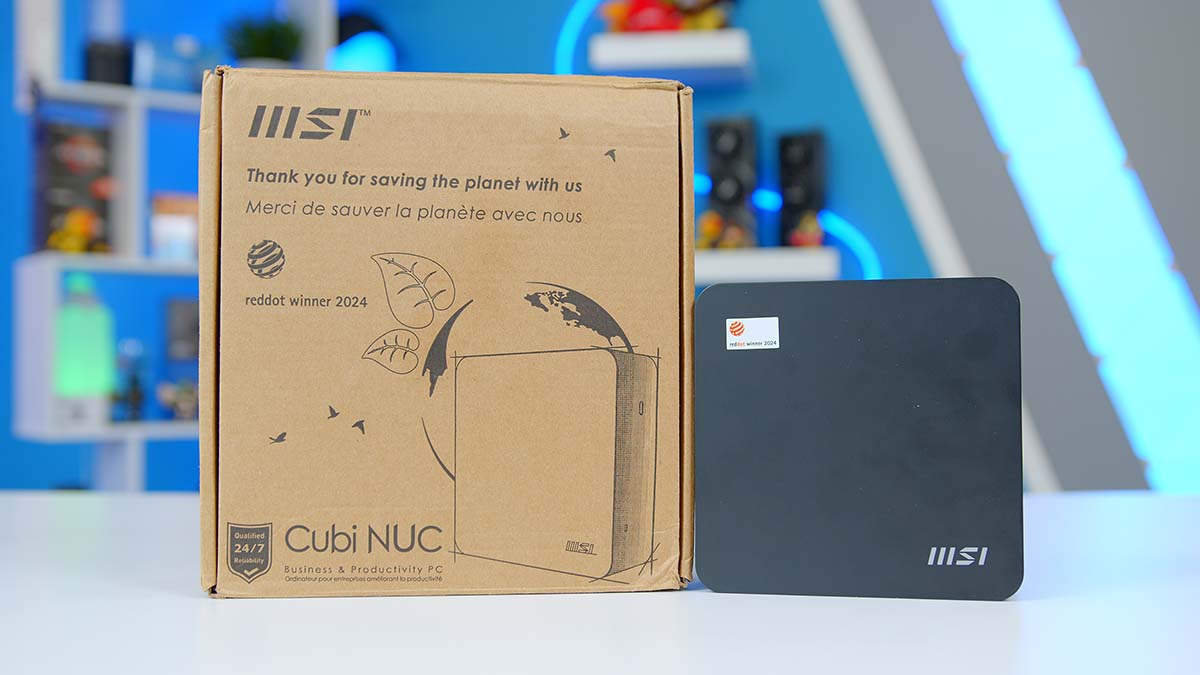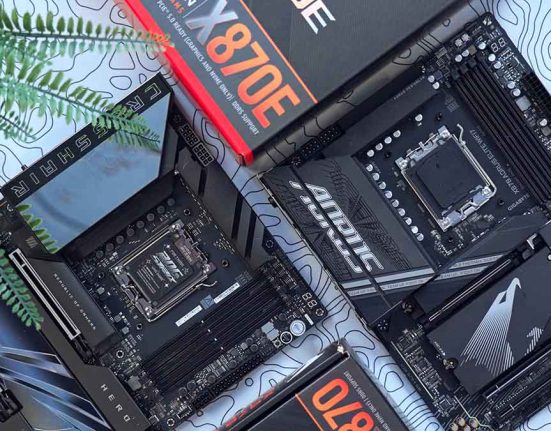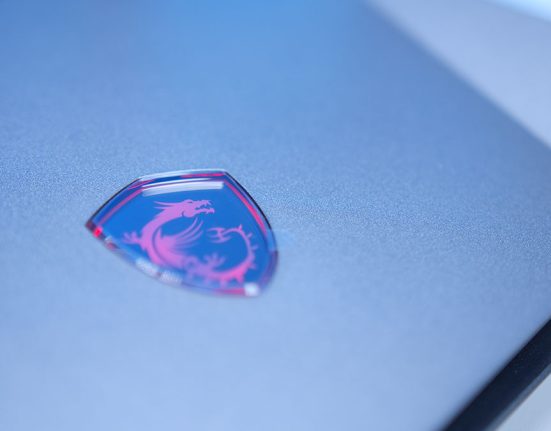The MSI Cubi NUC is a productivity-focused Mini PC designed to provide the tools and performance you need for an office setup. Leaning into the typical NUC design, the Cubi is a small form factor PC that can easily fit in the palm of your hand. It is built to be stealthy and offers a minimalist footprint, so it can easily be tucked away behind a monitor or on your desk for quick and easy access, but without hindering your setup.
Mini PCs have grown in popularity over the years, with more manufacturers offering their take on a small form factor design built to be hidden away. We’ve reviewed a few in the past, like the Zotac ZBOX systems, the Acer Predator Orion X, and the ASUS ROG NUC, all geared towards gaming. However, the Cubi NUC, as more of a productivity option, offers an interesting value proposition for work-from-home users or large office setups that need a cost-effective solution to supply staff with a well-powered PC.
However, with so many affordable laptops on the market, picking up a mini desktop machine may not be the remedy for everyone, especially as a NUC like the MSI Cubi requires a screen, mouse, keyboard, and potentially more storage, depending on your use case. But for now, we’ll leave the speculation until we’ve taken a more in-depth look at the performance and pricing.
In this review, we’ve done a deep dive into the MSI Cubi NUC, analysing its specs, design and features, along with a full test of its performance to see how it fares in various workloads.
Buy the MSI Cubi NUC on:
Specification
In terms of specs, the MSI Cubi NUC offers what you’d expect for a productivity-oriented PC. This system comes equipped with an Intel Core 7 150U, a ten-core, twelve-thread processor clocking up to a maximum of 5.4GHz. This reasonably efficient CPU has a maximum turbo power of 55W, so it isn’t particularly power-hungry despite clocking up to 5.4GHz, which is pretty impressive.

It features 16GB of DDR5 RAM, which maxes out at 5200MT/s. The Cubi NUC has a Western Digital SN560 1TB drive for storage. If this were gaming-focused, I’d say that 1TB likely isn’t enough, but for a productivity PC, this should be more than ample for most prospective buyers. This PC is powered by a 120W PSU, again demonstrating its efficiency, which is great to see.
Regarding the IO, there’s a decent selection on offer here. At the front, there’s a 3.5mm headphone and microphone combo jack, alongside two USB 3.2 Gen2 Type-A ports and a Micro SD card reader. At the back of the chassis, you’ll find two HDMI 2.1 ports, two Thunderbolt 4 Type-C ports, one of which works as DisplayPort out, along with two 2.5 Gigabit LAN ports and two additional USB 3.2 Gen2 Type-A ports. I’m pretty impressed with the port selection, despite being a small form factor PC, MSI has provided a solid selection of IO to leverage which caters to users with multiple devices and displays.
| Specifications | MSI Cubi NUC |
|---|---|
| Dimensions (L x W X H) | 132mm x 135mm x 50mm |
| CPU | Intel Core 7 150U |
| CPU Cooler | Fan-Cooled |
| RAM | 16GB DDR5 5200MT/s |
| Storage | WD SN560 1TB |
| Graphics Card | Internal Graphics |
| Power Supply | 120W |
| Front IO | 1 x Micro SD Card Reader 2 x USB 3.2 Gen2 Type-A 1 x 3.5mm Combo Jack |
| Rear IO | 2 x HDMI 2.1 Out 2 x Thunderbolt 4 Type-C (1 x DP-Out) 2 x USB 3.2 Gen2 Type-A |
| Networking | Dual 2.5 Gigabit LAN WiFi 6E |
| Operating System | Windows 11 Pro |
Lastly, the Cubi NUC comes with a pre-installed and activated copy of Windows 11 Pro. I imagine this won’t be the case on the bare-bones version of the NUC, but it’s great that this is a Pro version of Windows. While it won’t be necessary for all office setups, there are advantages to having Windows Pro, like Bitlocker Encryption, Windows Azure Active Directory, and more security across the board.
Before diving into the design, let’s quickly discuss pricing. Typically, the MSI Cubi NUC is sold as a standalone barebones unit with just a CPU, which means you’re required to supply and install the SSD, RAM, and operating system. This can be done for around £500 or so, which is about $645 at the time of writing, with the price jumping up to over $700 with certain configurations. While I think the bare-bones are affordable, especially for a business, spending a surplus of $200 for extra components doesn’t seem worth it.
MSI Cubi NUC Design
From a design point of view, the MSI Cubi NUC is a fairly sleek-looking device. It has a very small footprint, coming in at 132mm long, 135mm wide, and 50mm tall. If you’re looking to maintain a clean setup, it can be easily hidden away underneath a desk, wall-mounted, or even monitor-mounted. The Cubi NUC isn’t particularly heavy either, weighing 1.45kg in total.

As expected, the Cubi has a mostly cube-like shape with rounded edges. I’m a fan of the rounded design, as it gives the Cubi NUC more of a friendly look. The chassis is made of recycled plastic, which is a nice touch. MSI has taken a sustainable approach to creating this Mini PC, along with the packaging made from sustainable wood pulp. We’ve seen something similar with the ASUS ProArt PA401 case, so it’s excellent that MSI is putting the environment first when creating new products.

There’s not much more to cover regarding the outside of the Cubi NUC, primarily because this Mini PC is built more for function than form. The minimalist approach to the aesthetic makes it much easier to hide away within your setup. MSI also includes a VESA mount, providing you with a simple way to place the NUC behind a monitor or mount it to a wall.

Internally, there are a few design elements worth touching on. If we remove the four screws attached to the feet underneath the NUC, the bottom drops out, revealing the internals. Most of the slots are already populated because this isn’t a bare-bones kit. Based on the specs we provided earlier, the SODIMM slots have two 8GB sticks of Samsung DDR5 RAM. However, if this isn’t enough, you can swap these out for 32GB or even 64GB at the maximum.

Additionally, there are two M.2 slots. The primary slot on the motherboard uses the M.2 2280 form factor, which is a full-sized M.2 SSD. However, there’s a second Gen4 slot with space for an M.2 2242 SSD. This is the second smallest size and may be somewhat difficult to source based on its uniqueness.

From a glance at the top of the chassis, there’s a small set of vents towards the rear of the case with some heatsinks in view. Although we’re unable to get underneath the motherboard, I believe the cooling being provided for this NUC is a blower-style fan. This does mean that the MSI Cubi is likely to be a bit noisy during intense workloads, but because of its low power consumption, it’s more of a gentle whir instead of an aggressive buzzing from numerous fans.

Overall, I think the design is pretty impressive. It’s difficult to cram full desktop hardware into a small chassis, let alone one of this size. While there’s nothing particularly fancy about the look, it’s a Mini PC built for a purpose: to be hidden away or take up minimal space within a desktop setup.
MSI Cubi NUC Thermals & Performance
In this section, we’ll examine the overall performance and thermals. While the MSI Cubi NUC is a fairly low-powered system, it still needs to provide adequate cooling for the CPU and other components. For this reason, it’s worth examining the thermals to see how this Mini PC copes under stress.
CPU-Z Max Thread Run
At idle, we saw an average temperature of around 44°C. This is quite warm for idle, but this isn’t any cause for concern. During the max thread benchmark, the Core 7 150U hovered anywhere between 70°C and 85°C. Generally speaking, most laptop chips are designed to be more resilient with regard to thermals, so the 85°C maximum that we saw here again wasn’t concerning.
In terms of the score, CPU-Z saw an average of around 1670, with the boost speed of this CPU hovering around 3.9GHz on the first two cores and 3GHz on the remaining performance cores. Ultimately, this is happening because of the cooling. Maintaining higher clock speeds means hotter temperatures, so without more fans or perhaps even liquid cooling, the max we’ll see with 100% utilisation is around 4GHz or so, which isn’t bad, considering the power of this PC.
Cinebench 4 Thread
In our four-thread run, temperatures were generally lower on average, with the Core 7 150U sitting around 70°C or so, with some small jumps to 75°C. Idle hovered around 40°C-45°C, which is an acceptable range. The benchmark recording we’ve provided shows that the Cubi NUC score is around 215 points, which puts it reasonably low compared to other CPUs. From this data, it’s relatively clear that despite having quite a few cores, the Core 7 150U isn’t quite cut out for multi-threaded workloads.
Cinebench 8 Thread
In the eight-thread benchmark, temperatures were similar to what we saw during CPU-Z. There’s a bit more volatility in the temperature range as the cooling system tries to get a handle on the thermals, but we saw 85°C at the maximum, which wasn’t any cause for concern. In this final benchmarking run, the average score was much higher, with the Core 7 150U reaching around 280 points. Again, this benchmark somewhat demonstrates that the Cubi NUC, while designed as an office workstation, is better suited for lighter workloads.
Across the board, temperatures are what you’d expect. The small heatsink and fan attached to the Cubi NUC aren’t going to blow you away, but they provide adequate cooling for this Mini PC and don’t break the sound barrier, which is ideal in an office setup.
As for general performance, our data shows that the MSI Cubi NUC isn’t quite cut out for more burdensome multi-core workloads. There are a few instances that I can think of where the Cubi NUC would be able to handle a more intense workload, such as Photoshop and ZIP files. However, for the most part, the Cubi NUC is built for general office use, such as Microsoft Office, spreadsheets, web browsing, and other light loads.
Features We Like
Upgradeable Design
One of the excellent qualities of the MSI Cubi NUC is that it can be upgraded. Once you’ve unscrewed the outer casing, you’ll find two SO-DIMM RAM slots and two M.2 slots. It’s easy to install a higher quantity of RAM or a larger set of storage drives for those that need greater performance and more room for various files.

Uses Sustainable Materials
MSI has prioritised the environment in the design of the Cubi NUC. The chassis and outer casing are made of recycled plastic, while the box and packing materials use sustainable wood pulp. These are important design elements that manufacturers should consider when producing new products, as unsustainable practices drastically affect the environment, which has negative effects worldwide.

Features We Don’t Like
Cooling Fan Can Be Loud
During my time with the Cubi NUC, I noticed it wasn’t the quietest Mini PC we tested. The small fan assisting the cooling system inside this machine tends to spin up quite loud, which is likely to be annoying if you’re in a quiet office environment.

Looks and Feels Cheap
The main caveat of using a reasonably simplistic black plastic chassis is that it looks and feels a bit cheap. I’m a big fan of MSI’s commitment to the environment, but there’s no denying that the plain look and aesthetic won’t appeal to everyone.

Conclusion
MSI Cubi NUC
Product Name: Cubi NUC
Brand: MSI
-
Features
-
Design
-
Performance
-
Value For Money
Summary
The MSI Cubi NUC is a well-rounded small form factor Mini PC designed to provide prospective buyers with a portable machine that can be easily hidden away to maximise your office setup. For the most part, the Cubi NUC is geared towards office work based on its rather simplistic-looking design and support for multiple monitors. And this is even more clear when we look at the performance results, which from our data indicates that the Cubi NUC will struggle with tough single and multi-core workloads. I’m a big fan of the sustainable approach that MSI has taken, and I’m an even bigger fan of the fact that this is upgradeable.
However, the main caveat to consider is pricing. The Cubi NUC varies in price depending on which version you’ve configured, but this particular spec comes in at around £700, which is nearly $900 in the US. While I can appreciate the hard work and labour that’s gone into this Mini PC, there are solid laptops that you can find around this price point that will be able to do more, and they come with a screen, mouse and keyboard. There are some office environments that will appreciate the design of this Mini PC, but I think many will be put off by the price.
Pros
✅ Sustainable materials and packaging
✅ Upgradeable
✅ Can be easily hidden away
Cons
❌ Struggles with more than simple office work
❌ Looks and feels cheap
❌ Can get loud under stress








